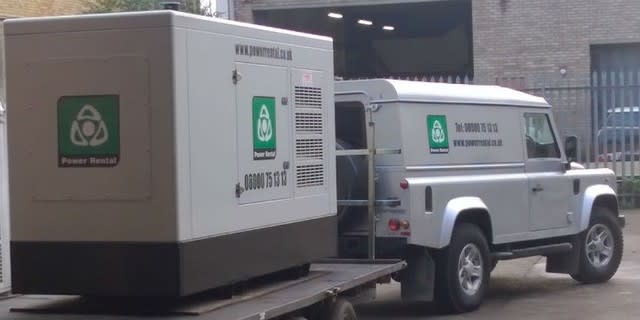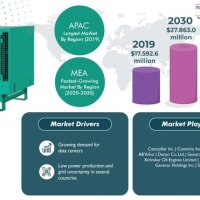
The global power rental market reached a value of $9,167.6 million in 2017 and is predicted to grow with a CAGR of 10.3% during the forecast period (2018–2023). The market is witnessing growth due to the gross domestic product (GDP) and population rise, natural disasters, and surging demand for power from the events and entertainment industry and emerging economies. Rental power is the temporary electricity generated by rental systems for meeting power requirements. Industries which are located in remote regions without access to permanent electricity supply generally use rental power.
On the basis of fuel type, the power rental market is categorized into gas generators, diesel generators, and others (which include solar fuel-based and gasoline/petrol generators). The market was led by the category of diesel generators during the historical period (2013–2017) with more than 75.0% share in 2017. This is attributed to the easy availability of diesel and increasing demand for such generators from the manufacturing and construction sectors. This category is further expected to dominate the market during the forecast period.
Get Sample Copy of Recent Development Free at: http://bit.ly/2rzoA29
When end-users are taken into consideration, the power rental market is divided into construction, mining, utilities, industrial, events, oil & gas, and others. The division of others includes manufacturing, residential & commercial buildings, military, and shipping. Among these, the division of utilities contributed more than 45.0% revenue to the market in 2017, and it is predicted to dominate the market during the forecast period as well. This is due to the presence of various thermal power plants which require steady power supply during maintenance, conversion, or shut down.
One of the key driving factors of the power rental market is the upsurge in demand for such devices from the events and entertainment industry. This industry is flourishing currently due to the rising number of events that are being organized, such as concerts, product launches, private functions, sports leagues, weddings, fairs, and festival celebrations. For the smooth running of these events, the industry requires rental power for both short and long durations. Power rental companies provide reliable and efficient light towers and generators of different power ratings for the events.
The occurrence of natural disasters is also leading to the growth of the power rental market. Natural disasters, such as tsunamis, hurricanes, floods, tornadoes, and earthquakes, cause huge economic damage and loss of life. Often, these calamities result in environmental problems, famines, and power cuts. The recovery and mitigation process after such disasters involves large-scale reconstruction activities and relief work, which are primarily facilitated by power rental equipment provided by companies.
A major trend in the power rental market is the growing popularity of hybrid and gas generators. Propane, hydrogen, and natural gas are some gases that are being used in power generators as fuel. As gas-based generators release less emissions and create less noise than traditional fuel-based generators, they are considered cost-effective and environment-friendly. Hybrid generators are those which work on the bi-fuel operation mode, using random combinations of diesel, gas, and solar energy. These generators are easily available, sustainable, and clean, and because of these factors, their popularity is increasing.
Hence, the occurrence of natural disasters and rising demand for rental power from the events and entertainment industry are leading to the growth of the market.
On the basis of fuel type, the power rental market is categorized into gas generators, diesel generators, and others (which include solar fuel-based and gasoline/petrol generators). The market was led by the category of diesel generators during the historical period (2013–2017) with more than 75.0% share in 2017. This is attributed to the easy availability of diesel and increasing demand for such generators from the manufacturing and construction sectors. This category is further expected to dominate the market during the forecast period.
Get Sample Copy of Recent Development Free at: http://bit.ly/2rzoA29
When end-users are taken into consideration, the power rental market is divided into construction, mining, utilities, industrial, events, oil & gas, and others. The division of others includes manufacturing, residential & commercial buildings, military, and shipping. Among these, the division of utilities contributed more than 45.0% revenue to the market in 2017, and it is predicted to dominate the market during the forecast period as well. This is due to the presence of various thermal power plants which require steady power supply during maintenance, conversion, or shut down.
One of the key driving factors of the power rental market is the upsurge in demand for such devices from the events and entertainment industry. This industry is flourishing currently due to the rising number of events that are being organized, such as concerts, product launches, private functions, sports leagues, weddings, fairs, and festival celebrations. For the smooth running of these events, the industry requires rental power for both short and long durations. Power rental companies provide reliable and efficient light towers and generators of different power ratings for the events.
The occurrence of natural disasters is also leading to the growth of the power rental market. Natural disasters, such as tsunamis, hurricanes, floods, tornadoes, and earthquakes, cause huge economic damage and loss of life. Often, these calamities result in environmental problems, famines, and power cuts. The recovery and mitigation process after such disasters involves large-scale reconstruction activities and relief work, which are primarily facilitated by power rental equipment provided by companies.
A major trend in the power rental market is the growing popularity of hybrid and gas generators. Propane, hydrogen, and natural gas are some gases that are being used in power generators as fuel. As gas-based generators release less emissions and create less noise than traditional fuel-based generators, they are considered cost-effective and environment-friendly. Hybrid generators are those which work on the bi-fuel operation mode, using random combinations of diesel, gas, and solar energy. These generators are easily available, sustainable, and clean, and because of these factors, their popularity is increasing.
Hence, the occurrence of natural disasters and rising demand for rental power from the events and entertainment industry are leading to the growth of the market.




















※コメント投稿者のブログIDはブログ作成者のみに通知されます